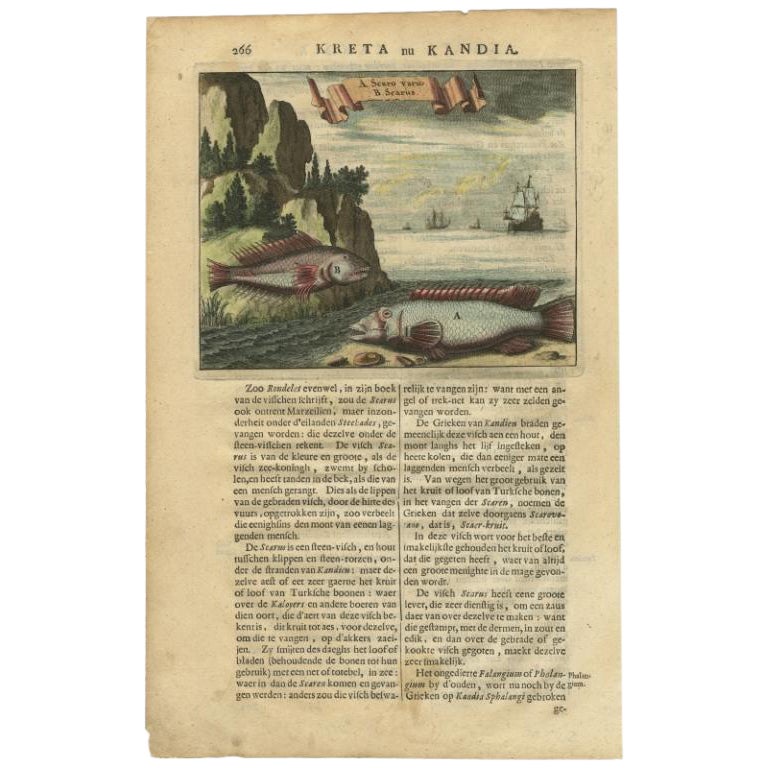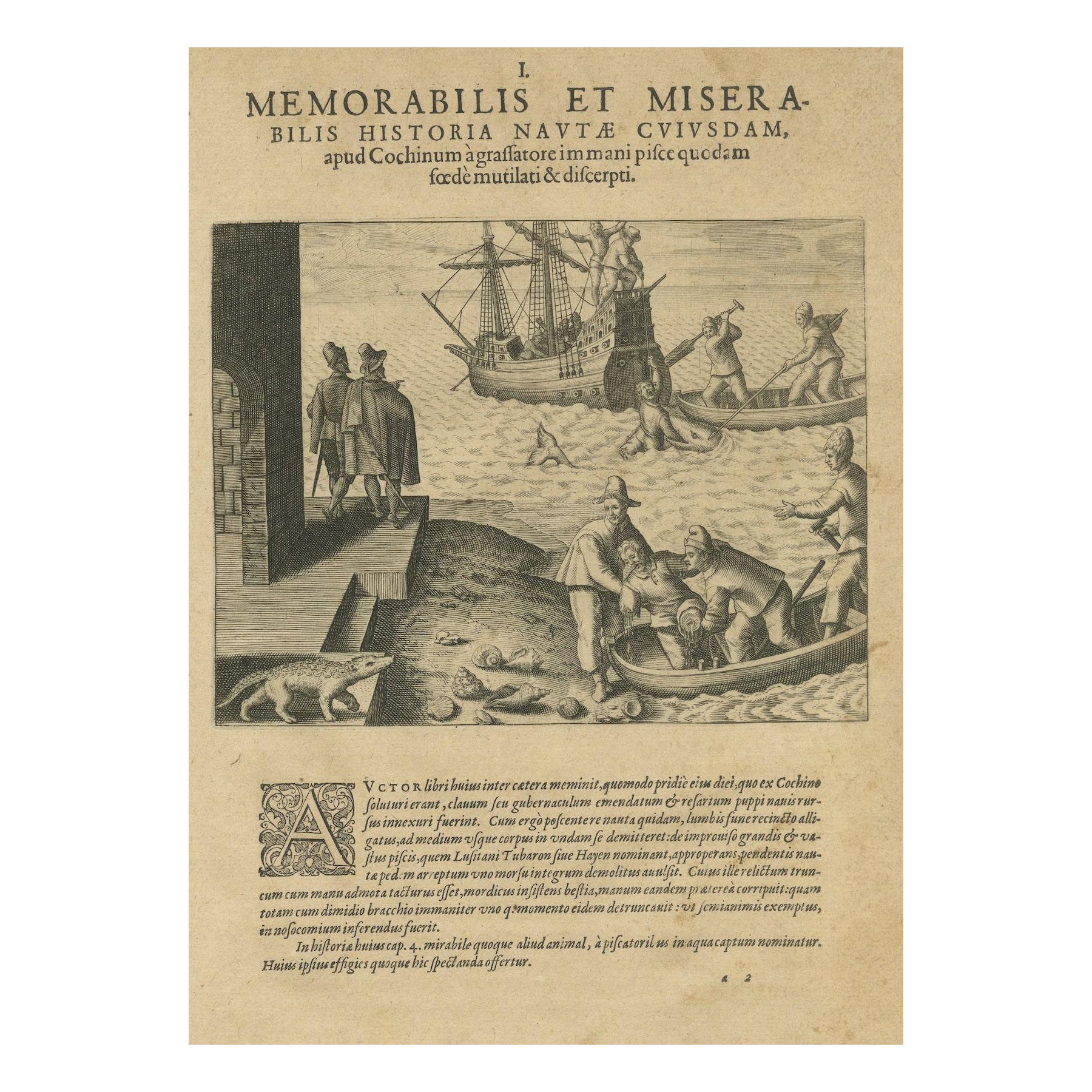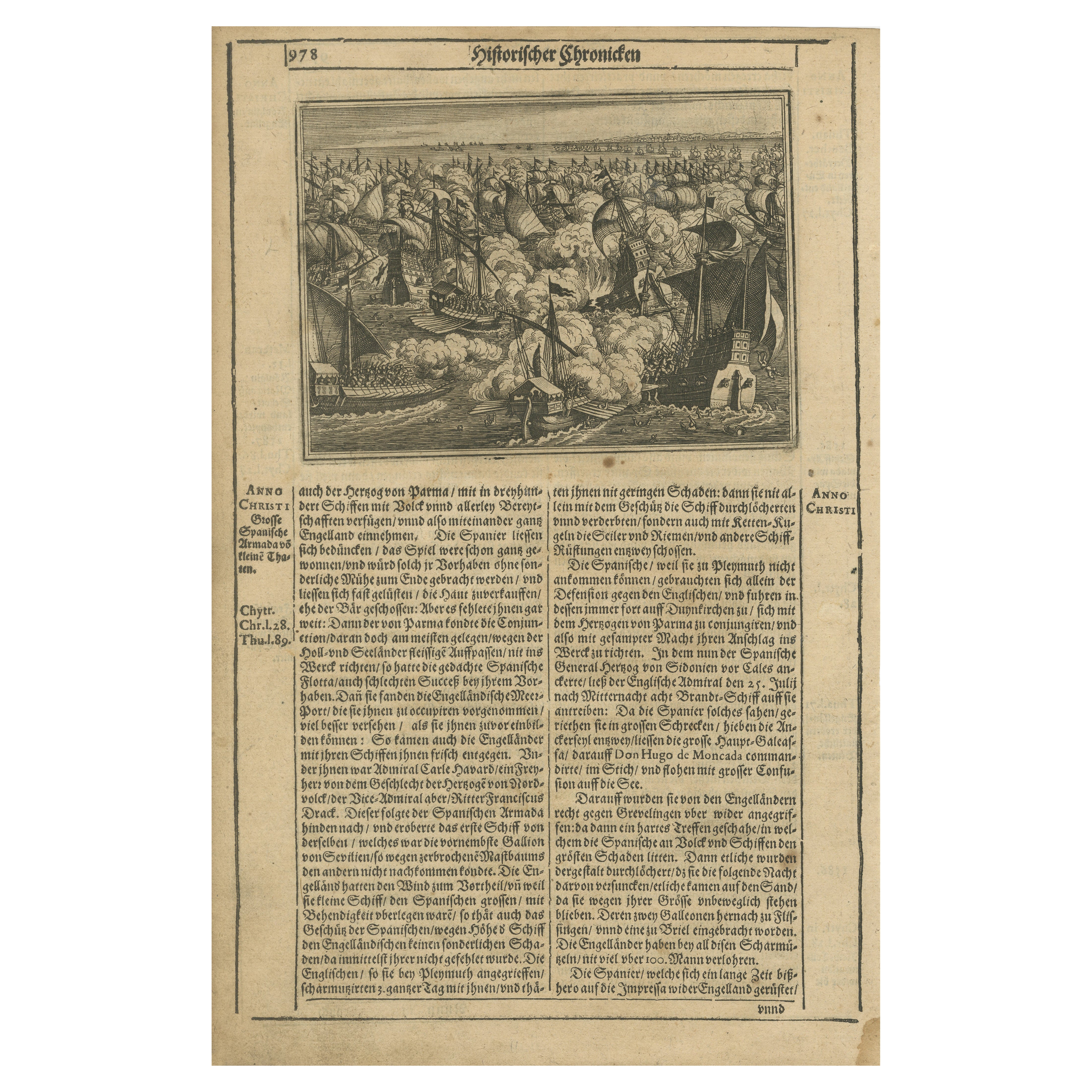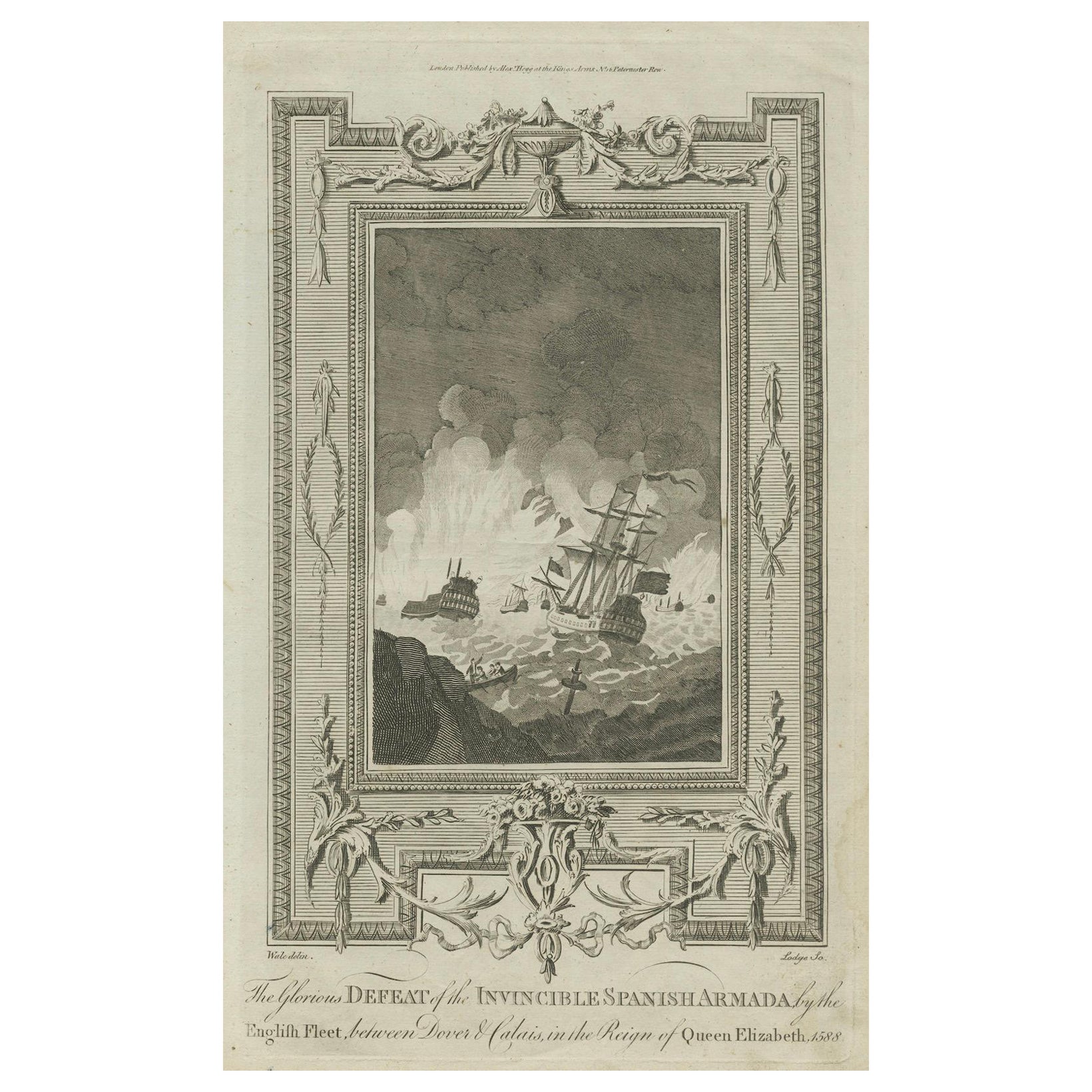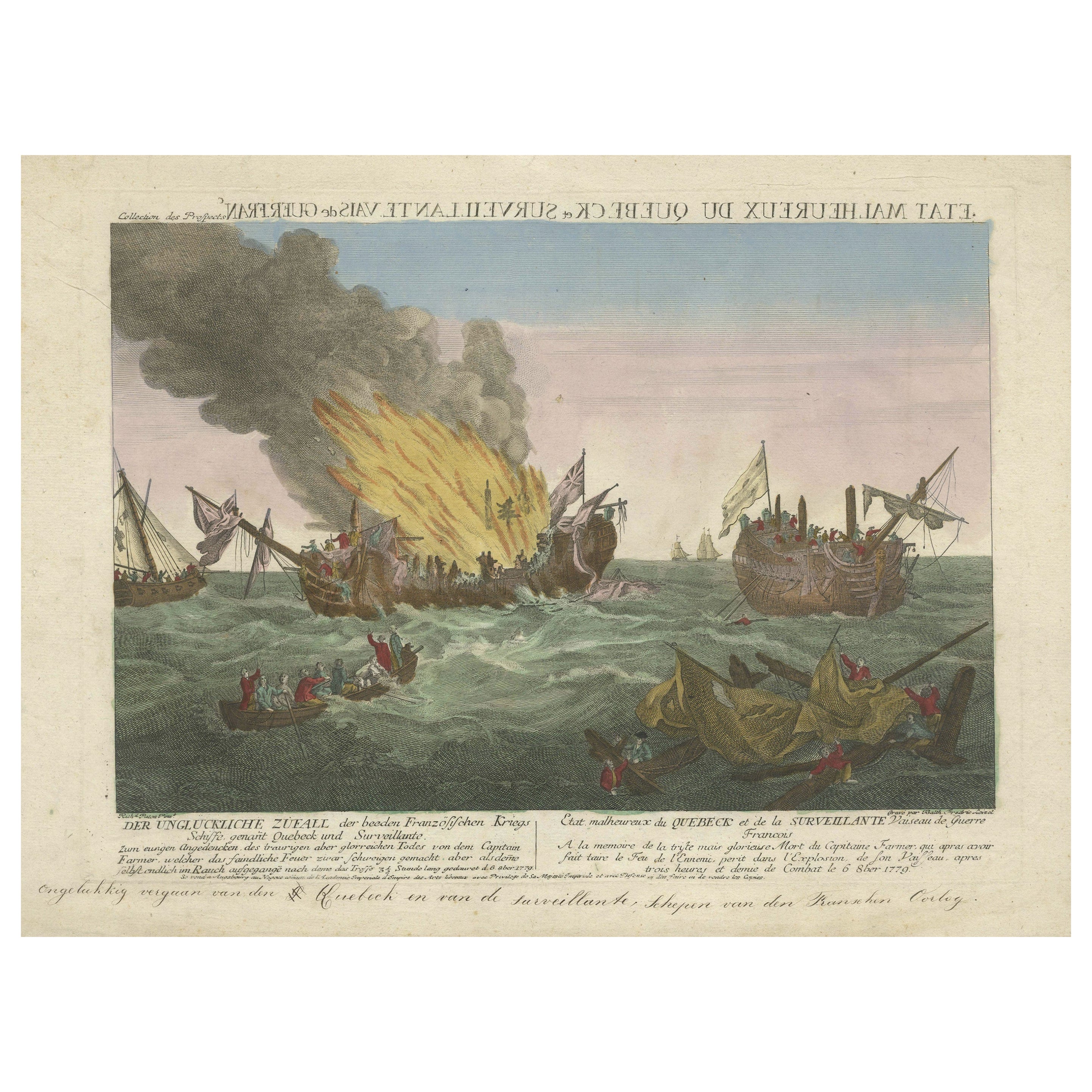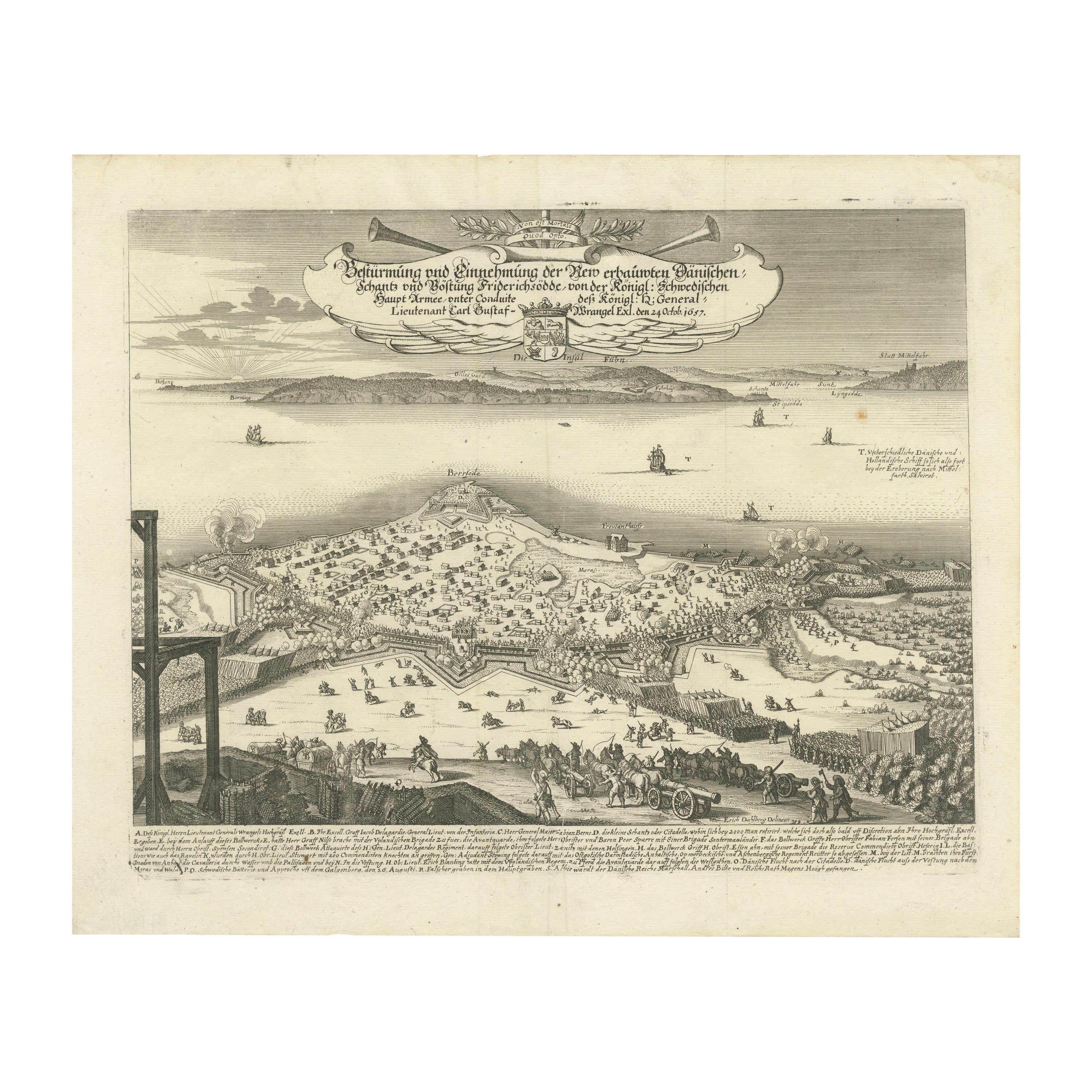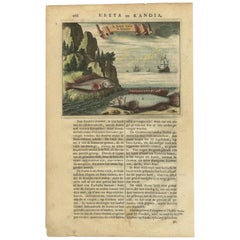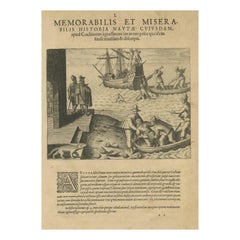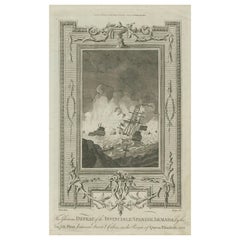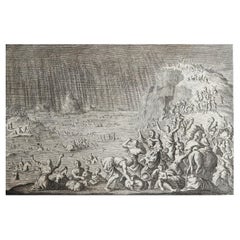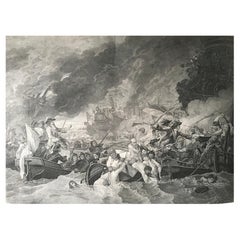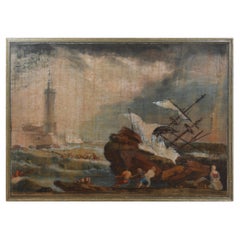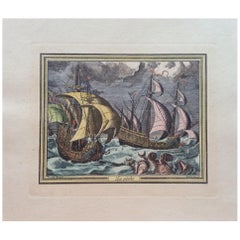Items Similar to The Fury of the Azores: Shipwreck Disaster at Terceira, Engraved in circa 1610
Want more images or videos?
Request additional images or videos from the seller
1 of 10
The Fury of the Azores: Shipwreck Disaster at Terceira, Engraved in circa 1610
$443.54
£329.49
€370
CA$615.90
A$672.09
CHF 352.52
MX$8,162.79
NOK 4,403.22
SEK 4,161.26
DKK 2,816.77
About the Item
The Fury of the Azores: Shipwreck Disaster at Terceira, from Linschoten's 1610 Work
This dramatic hand-colored engraving, titled 'Saevissima Tempestas ad Terceiram' (The Most Savage Storm at Terceira), vividly depicts a catastrophic shipwreck off the coast of Terceira Island in the Azores. The print dates back to the early 17th century and was published as part of Jan Huygen van Linschoten’s renowned work 'Tertia Pars Indiae Orientalis', printed in 1610.
This monumental work, a crucial part of the larger compilation known as 'Itinerario: Voyage ofte Schipvaert van Jan Huygen van Linschoten naer Oost ofte Portugaels Indien' (1596), was one of the most influential travel accounts of the Age of Exploration.
Linschoten’s travel narratives were instrumental in expanding European knowledge of Asian trade routes, maritime navigation, and the diverse cultures encountered during his journeys. As an explorer and merchant who spent years in Portuguese Asia, he meticulously documented his observations, which later served as valuable guides for Dutch and English expeditions to the East Indies. The Tertia Pars Indiae Orientalis specifically contained accounts of maritime disasters and navigational challenges, making this engraving a fitting representation of the risks of oceanic voyages during that era.
The engraving masterfully captures the fury of the storm, illustrating several ships being tossed and shattered by the relentless waves, with desperate survivors clinging to wreckage or attempting to reach the rocky shore. The scene is bustling with activity: locals are depicted trying to rescue survivors, while others survey the devastating loss. The sky is ominously dark, with swirling clouds emphasizing the merciless force of nature. Barrels and cargo drift aimlessly among the wreckage, symbolizing the immense loss of life and goods.
The Latin text beneath the image recounts the tragic event, describing how over 140 ships of the Spanish treasure fleet, returning from the New World, were caught in the tempest and destroyed. This catastrophic loss not only claimed countless lives but also sent vast quantities of precious cargo to the ocean floor. The ornate initial letter at the start of the text is meticulously decorated, adding a Renaissance flair that complements the tragic narrative.
Executed with precision, the print combines fine line engraving with hand-applied watercolor, typical of early 17th-century printmaking techniques. The careful shading and vibrant yet muted color palette enhance the sense of chaos and despair while maintaining a certain elegance characteristic of the period’s visual storytelling.
What makes this engraving particularly significant is its historical context as a part of Linschoten’s travel accounts. His works served as key resources for subsequent European expeditions, offering crucial information about sailing routes, hazards, and foreign ports. The vivid portrayal of maritime disasters like this one served both as a cautionary tale and a visual documentation of the harsh realities faced by explorers.
Condition: The print is in good condition for its age, with minor toning and light foxing typical of early hand-colored engravings. The colors remain vibrant, and the paper shows minimal wear.
Framing tips: To preserve its historical and visual impact, consider framing it in a dark wooden or ebony frame with an acid-free mat to protect the delicate paper while enhancing its dramatic presence.
- Dimensions:Height: 11.42 in (29 cm)Width: 7.49 in (19 cm)Depth: 0.01 in (0.2 mm)
- Materials and Techniques:Paper,Engraved
- Period:1610-1619
- Date of Manufacture:circa 1610
- Condition:The print is in good condition for its age, with minor toning and light foxing typical of early hand-colored engravings. The colors remain vibrant, and the paper shows minimal wear.
- Seller Location:Langweer, NL
- Reference Number:Seller: BG-043391stDibs: LU3054344139082
About the Seller
5.0
Recognized Seller
These prestigious sellers are industry leaders and represent the highest echelon for item quality and design.
Platinum Seller
Premium sellers with a 4.7+ rating and 24-hour response times
Established in 2009
1stDibs seller since 2017
2,641 sales on 1stDibs
Typical response time: <1 hour
- ShippingRetrieving quote...Shipping from: Langweer, Netherlands
- Return Policy
Authenticity Guarantee
In the unlikely event there’s an issue with an item’s authenticity, contact us within 1 year for a full refund. DetailsMoney-Back Guarantee
If your item is not as described, is damaged in transit, or does not arrive, contact us within 7 days for a full refund. Details24-Hour Cancellation
You have a 24-hour grace period in which to reconsider your purchase, with no questions asked.Vetted Professional Sellers
Our world-class sellers must adhere to strict standards for service and quality, maintaining the integrity of our listings.Price-Match Guarantee
If you find that a seller listed the same item for a lower price elsewhere, we’ll match it.Trusted Global Delivery
Our best-in-class carrier network provides specialized shipping options worldwide, including custom delivery.More From This Seller
View AllRare Engraving Picturing Fish from Crete and Dutch Ships, Coloured, 1688
Located in Langweer, NL
Antique print, titled: 'A. Scaro vario - B. Scarius.' - Kreta nu Kandia on top of the page. This original antique print shows fish from Crete with ships in the background. Dutch text...
Category
Antique 17th Century Prints
Materials
Paper
$129 Sale Price
20% Off
The de Bry Engraving of Maritime Marvels of Dutch Seafarers at Cochin, 1601
Located in Langweer, NL
Engraving by Theodore De Bry from 'Pars Quarta Indiae Orientalis...,' 1601, with descriptive latin text below the image.
This antique engraving of ov...
Category
Antique Early 17th Century Prints
Materials
Paper
$469 Sale Price
20% Off
The Spanish Armada’s Defeat: A 17th-Century German Chronicle Engraving
Located in Langweer, NL
The Spanish Armada’s Defeat: A 17th-Century German Chronicle Engraving
This impressive 17th-century engraving, titled *Historischer Chronicken*, vividly depicts the dramatic naval...
Category
Antique 1680s Prints
Materials
Paper
Defeat of the Spanish Armada, 1588: 18th-Century Engraving by Alexander Hogg
Located in Langweer, NL
This striking 18th-century engraving, titled 'The Glorious Defeat of the Invincible Spanish Armada by the English Fleet, between Dover & Calais, in the Reign of Queen Elizabeth, 1588...
Category
Antique 1780s Prints
Materials
Paper
Rare Engraving of a Famous Battle Near Ushant Between the French and British
Located in Langweer, NL
Antique print titled 'Der ungluckliche Zufall der beeden Frazösischen Kriegs (..) - Etat malheureux de Quebeck et de la Surveillante (..)'. An engraving of a painting by Richard Paton of the three and a half hour long naval battle of 6 October 1779 which was fought off Ushant between HMS Quebec, under the command of Captain George Farmer, and the Surveillante, under the command of Captain Couédic de Kergoaler. The Quebec caught fire and exploded, and the British crew were rescued by the French. Captain George Farmer (b.1732) died in the battle. American War of Independence...
Category
Antique Late 18th Century Prints
Materials
Paper
$652 Sale Price
20% Off
Prince Henry's Naval and Land Battle during the Seven Years' War Engraved, 1667
Located in Langweer, NL
The engraving depicts the assault and capture of the Danish fortress Friderichsodde (now known as Fredericia) located on the island of Fyn. The scene, captured on October 24, 1657, vividly illustrates the Swedish main army's takeover under the command of General Carl Gustaf Wrangel. This historical event is meticulously documented in the artwork, which showcases not only the military action but also the strategic landscape and fortifications characteristic of the time.
Erik Jönsson Graf von Dahlberg, the artist behind this work, was a prominent Swedish field marshal, architect, and fortress builder. Born in 1625 and passing in 1703, Dahlberg's contributions to military and architectural fields were significant. He was renowned for his detailed and artistically valuable drawings which served as the basis for large-scale copperplate engravings. These engravings are of substantial topographical and architectural historical importance as they provide a detailed visual account of Swedish territories during the era.
In 1661, Dahlberg began work on his magnum opus—a comprehensive geographical and historical depiction of Swedish territories, which received royal privileges. His journey in 1667-1668 to Paris for the engraving of the initial plates reflects the international scope and ambition of his project. However, the work was intermittently paused when Dahlberg was tasked in 1674 with overseeing all Swedish fortress constructions, a role that significantly impacted his career and works. The project resumed and was published in 1684, highlighting a significant period of Swedish history and military achievements under his visual documentation.
MORE ABOUT THE BATTLE:
The image is an intricate engraving depicting a battle scene. Based on the details and the text in the cartouche, the scene illustrates a significant historical battle involving Prussian forces. The presence of multiple ships and extensive fortifications suggests a combined land and naval engagement.
Key Features in the Engraving:
1. Land Battle: The forefront of the image shows numerous troops, artillery pieces, and cavalry in action, depicting the intensity and scale of the land combat.
2. Naval Elements: Ships in the background indicate that this battle had a naval component, which would have been crucial for controlling trade routes or strategic waterways.
3. Fortifications: Extensive fortifications, including bastions and protective walls, suggest a well-defended location, possibly a city or a significant stronghold.
Historical Context:
From the text, it appears the battle involves "Prinz Heinrich," referring to Prince Henry of Prussia, who was an influential military leader during the reign of his brother, Frederick the Great. Under Frederick’s rule, Prussia engaged in several key conflicts, including the Seven Years' War (1756-1763), which saw major battles across Europe and involved complex alliances.
Given the level of detail and the era suggested by the style of ships and fortifications, the battle was of the significant engagements during the Seven Years' War, where Prince Henry played a critical role. His campaigns often involved maneuvering to protect Prussia from multiple fronts, including naval engagements in the Baltic.
Interpretation:
This engraving serves not only as a historical document but also as a piece of propaganda, likely glorifying the prowess and strategic capabilities of the Prussian military...
Category
Antique 1670s Prints
Materials
Paper
$441 Sale Price
20% Off
You May Also Like
Original Antique Print After Jan Luyken, Amsterdam, Genesis VII, 1724
Located in St Annes, Lancashire
Wonderful copper-plate engraving after Jan Luyken
Published by Marten Schagen, Amsterdam. 1724
Text on verso
The measurement given is the paper size.
Category
Antique 1720s Dutch Renaissance Prints
Materials
Paper
B.West Engraving "Naval Battle, Battle of the Houge" 18th Century
Located in Beuzevillette, FR
This magnificent engraving is entitled "Battle of La Hougue" by the engraver E.C Voysard after Benjamin West.
It depicts the Battle of Barfleur- La Hougue,...
Category
Antique 18th Century French Prints
Materials
Paper
A Stormy Sea Painting – Late 18th Century Oil on Canvas
Located in North Miami, FL
This captivating oil on canvas painting, believed to date from the late 18th century, depicts a dramatic shipwreck near a towering lighthouse. The scene captures the chaos of a storm...
Category
Antique 18th Century European Paintings
Materials
Canvas
18th Century Color Engraving Print by Pieter F.H. Bruegel, La Peche
Located in Miami, FL
Original 18th century color engraving print by renowned artist Pe. F.H. Bruegel.
A fine crisp impression of great rarity; it is particularly unusual to find color engravings of this...
Category
Antique 18th Century French Prints
Materials
Paper
F. CEPPARULI (*1750) after VANNI (*1750), "Temple on an Island in the Water"
Located in Madrid, ES
F. CEPPARULI (*1750) after VANNI (*1750), Temple on an Island in the Water, circa 1780
Copper engraving Francesco Cepparuli (before 1750 - after 1767 ) after Niccolo Vanni (before 1...
Category
Antique 18th Century Italian Baroque Drawings
Materials
Paint
Early 18th Century Engraving of the Northern Whale Fishery, circa 1720
Located in Nantucket, MA
Very early 18th century Dutch woodblock engraving of the Northern Whale Fishery, circa 1720, a hand colored engraving illustrating the Dutch whaling flee...
Category
Antique 1720s Dutch Baroque Prints
Materials
Paper
More Ways To Browse
Spindle Desk
Stained Glass Flowers
Star Bowl
Stone Buddha Statue
Swan Metal Table
Swedish Grace Cabinet
Tall Boy Cabinet
Tall Stone Sculptures
Tara Tibetan
Teak Bone Inlay
Terracotta Bulldog
Terracotta Cat
Terracotta Storage Jar
Thayer Coggin Burl Wood
Thomas Webb Crystal
Tiffany Bronze Clock
Tiffany French Clock
Tiffany Windows
